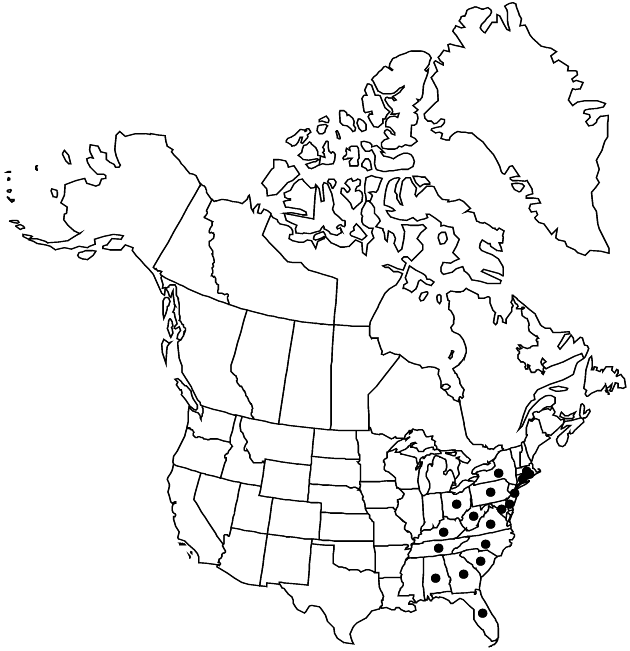Difference between revisions of "Doellingeria infirma"
Pittonia 3: 52. 1896.
FNA>Volume Importer |
imported>Volume Importer |
||
| (6 intermediate revisions by 2 users not shown) | |||
| Line 8: | Line 8: | ||
}} | }} | ||
|common_names=Cornel-leaved or cornel-leaf whitetop aster | |common_names=Cornel-leaved or cornel-leaf whitetop aster | ||
| − | |basionyms={{Treatment/ID/ | + | |special_status={{Treatment/ID/Special_status |
| + | |code=E | ||
| + | |label=Endemic | ||
| + | }} | ||
| + | |basionyms={{Treatment/ID/Basionym | ||
|name=Aster infirmus | |name=Aster infirmus | ||
|authority=Michaux | |authority=Michaux | ||
| + | |rank=species | ||
| + | |publication_title=Fl. Bor.-Amer. | ||
| + | |publication_place=2: 109. 1803 | ||
}} | }} | ||
|synonyms={{Treatment/ID/Synonym | |synonyms={{Treatment/ID/Synonym | ||
|name=Aster cornifolius | |name=Aster cornifolius | ||
|authority=Muhlenberg ex Willdenow | |authority=Muhlenberg ex Willdenow | ||
| − | }}{{Treatment/ID/Synonym | + | |rank=species |
| + | }} {{Treatment/ID/Synonym | ||
|name=Aster humilis | |name=Aster humilis | ||
|authority=Willdenow | |authority=Willdenow | ||
| − | }}{{Treatment/ID/Synonym | + | |rank=species |
| + | }} {{Treatment/ID/Synonym | ||
|name=Diplopappus cornifolius | |name=Diplopappus cornifolius | ||
|authority=(Muhlenberg ex Willdenow) Lessing ex Darlington | |authority=(Muhlenberg ex Willdenow) Lessing ex Darlington | ||
| − | }}{{Treatment/ID/Synonym | + | |rank=species |
| + | }} {{Treatment/ID/Synonym | ||
|name=Diplostephium cornifolium | |name=Diplostephium cornifolium | ||
|authority=(Muhlenberg ex Willdenow) de Candolle | |authority=(Muhlenberg ex Willdenow) de Candolle | ||
| − | }}{{Treatment/ID/Synonym | + | |rank=species |
| + | }} {{Treatment/ID/Synonym | ||
|name=Doellingeria cornifolia | |name=Doellingeria cornifolia | ||
|authority=(Muhlenberg ex Willdenow) Nees | |authority=(Muhlenberg ex Willdenow) Nees | ||
| − | }}{{Treatment/ID/Synonym | + | |rank=species |
| + | }} {{Treatment/ID/Synonym | ||
|name=Doellingeria humilis | |name=Doellingeria humilis | ||
|authority=(Willdenow) Britton | |authority=(Willdenow) Britton | ||
| − | }}{{Treatment/ID/Synonym | + | |rank=species |
| + | }} {{Treatment/ID/Synonym | ||
|name=Doellingeria umbellata var. humilis | |name=Doellingeria umbellata var. humilis | ||
|authority=(Willdenow) W. Stone | |authority=(Willdenow) W. Stone | ||
| + | |rank=variety | ||
}} | }} | ||
|hierarchy=Asteraceae;Asteraceae tribe Astereae;Doellingeria;Doellingeria infirma | |hierarchy=Asteraceae;Asteraceae tribe Astereae;Doellingeria;Doellingeria infirma | ||
| Line 48: | Line 62: | ||
|elevation=10–100 m | |elevation=10–100 m | ||
|distribution=Ala.;Conn.;Del.;Fla.;Ga.;Ky.;Md.;Mass.;N.J.;N.Y.;N.C.;Ohio;Pa.;R.I.;S.C.;Tenn.;Va.;W.Va. | |distribution=Ala.;Conn.;Del.;Fla.;Ga.;Ky.;Md.;Mass.;N.J.;N.Y.;N.C.;Ohio;Pa.;R.I.;S.C.;Tenn.;Va.;W.Va. | ||
| − | |discussion=<p>Doellingeria infirma is found in the Appalachian Mountains, the Piedmont and adjacent plateaus, to northern Florida.</p> | + | |discussion=<p><i>Doellingeria infirma</i> is found in the Appalachian Mountains, the Piedmont and adjacent plateaus, to northern Florida.</p> |
|tables= | |tables= | ||
|references= | |references= | ||
| Line 57: | Line 71: | ||
-->{{#Taxon: | -->{{#Taxon: | ||
name=Doellingeria infirma | name=Doellingeria infirma | ||
| − | |||
|authority=(Michaux) Greene | |authority=(Michaux) Greene | ||
|rank=species | |rank=species | ||
| Line 71: | Line 84: | ||
|publication title=Pittonia | |publication title=Pittonia | ||
|publication year=1896 | |publication year=1896 | ||
| − | |special status= | + | |special status=Endemic |
| − | |source xml=https:// | + | |source xml=https://bitbucket.org/aafc-mbb/fna-data-curation/src/2e0870ddd59836b60bcf96646a41e87ea5a5943a/coarse_grained_fna_xml/V19-20-21/V20_61.xml |
|tribe=Asteraceae tribe Astereae | |tribe=Asteraceae tribe Astereae | ||
|genus=Doellingeria | |genus=Doellingeria | ||
Latest revision as of 21:04, 5 November 2020
Plants 40–120 cm (crowns short, woody). Stems 1, ascending to erect, slightly to strongly flexuous, striate, glabrous. Cauline leaves: mid and distal not crowded, blades broadly lanceolate to oblanceolate, 50–130 × 15–45 mm, reduced and narrower distally, bases cuneate, margins flat to ± involute, finely ciliate, apices acuminate, faces glabrous or sparsely hairy. Heads (1–)3–33(–78). Peduncles 1–10 mm (leafless or nearly so), sparsely to moderately canescent; bracts linear-lanceolate to broadly lanceolate. Involucres 3.8–6.8 mm. Phyllaries in 4–5 series, midveins usually swollen and translucent, apices narrowly rounded, glabrate. Rays (3–)4–8(–11); laminae 6–12(–14.5) × 1–3.3 mm. Disc florets 4–13(–20); corollas 4–7 mm, lobes 2.5–3.5 mm, 50–75% of limbs. Cypselae 1.8–3.8 mm, 6–10-ribbed, glabrous, rarely sparsely strigose, sometimes sparsely glandular; pappi: outer 0.5–1 mm, inner 3.9–5 mm. 2n = 18.
Phenology: Flowering mid summer–early fall.
Habitat: Rich loam and dry rocky soils, deciduous woods, mountains and adjacent plateaus
Elevation: 10–100 m
Distribution

Ala., Conn., Del., Fla., Ga., Ky., Md., Mass., N.J., N.Y., N.C., Ohio, Pa., R.I., S.C., Tenn., Va., W.Va.
Discussion
Doellingeria infirma is found in the Appalachian Mountains, the Piedmont and adjacent plateaus, to northern Florida.
Selected References
None.